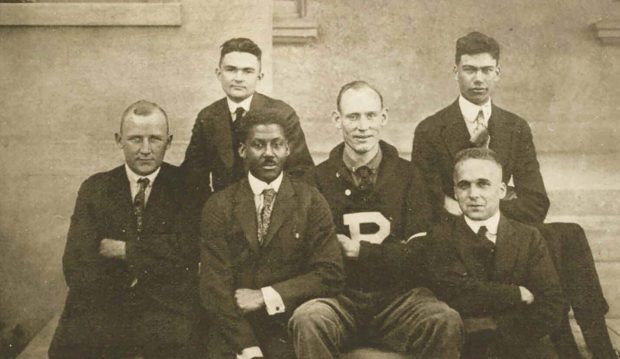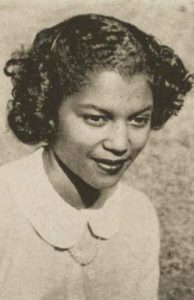
Pomona’s 1919 Debate Club, including Arthur Williams 1919 (front row, second from left). The College’s second Black graduate, Williams would go on to become a physician in White Plains, New York.
Desai: “… For the next three months, we’ll be investigating the questions about our school that we’ve had since orientation. What were relations like between the College’s founders and the original inhabitants of the land? How exactly did this decidedly New England-style liberal arts college get founded in the middle of Southern California? And what are the stories of the early students of color at the school?
“Let’s start with that last one. Right now we’re going to focus on the period between 1887, when Pomona was founded, and 1958, when the College accepted its first cohort of Black students. But for its first seven decades, the College was almost entirely white. That’s not to say that some students of color didn’t attend or even thrive at Pomona, however. …
“Winston M.C. Dickson arrived in Claremont in 1900 at a time when there probably weren’t any other African Americans in the Inland Empire, and only about 2,000 in the entire city of L.A. He was born to two freed slaves in 1872 in a farming community close to Crockett, Texas, which means he actually would have been almost 30 when he arrived at Pomona. There basically wasn’t any public education for Blacks in the South at the time, so it makes sense that it took him some time to get to Pomona. I’m really curious as to how Winston Dickson could have ended up here in 1900, especially considering that Claremont is more than 1,000 miles away from Houston and that Pomona was pretty much unknown at that point and had fewer than 100 students. Probably the only explanation that makes sense is that the Congregationalist Church played some role in getting him to Claremont. Both Pomona and Tillotson College, a small Black college where Winston Dickson studied before coming here, were founded by the Congregationalist Church. During his four years at Pomona, Winston Dickson seems to have thrived. I looked through all the yearbooks from his time on campus and was absolutely floored by how many clubs and organizations he was a part of—The Student Life, the Choral Union, the Literary Society and the Prohibition League…”
Tidmarsh: “Wow, he was all over, as Pomona students are wont to do.”
Desai: “So there’s a ton of photos of Winston Dickson from his time at Pomona, and he really seemed to be an integrated member of his class. In some pictures, he’s standing off to the side, and while he’s a member of an early frat on campus, he’s not pictured in most of their photos, for some reason.”
Tidmarsh: “It’s not hard to imagine why.”

Williams’ daughter, Eileen Williams ’50, the first Black woman to graduate from Pomona College.
Desai: “What’s really amazing to me is that Winston Dickson was the Class Day speaker for the Class of 1904, and an L.A. Times reporter who made the trek to Claremont for the event wrote that he had, quote, ‘the magnetic voice and manner of a trained orator.’ He was actually the first Black graduate of any college or university in Southern California. Then he got law degrees from Harvard and Boston University, and for the next half-century, he established himself as one of the most well respected Black attorneys in Houston, Texas. In 1915, there were just 19 Black attorneys in all of Houston, serving a Black population that had swelled to 30,000 people. Most of the cases he litigated were in the divorce or probate courts, which seemed kind of strange to me, but then I talked to a professor who studies the history of Black Houston, and he said that basically, this was all the work that Black lawyers could do at that point. It was such a difficult profession that many Black attorneys decided to leave it entirely. Over the course of his career, he became the president of the city’s Colored Bar Association and then later helped found the Houston Lawyers Association, a mentoring organization for Black attorneys that still exists today. From a son of freed slaves to a Pomona- and Harvard-educated lawyer in Houston, it’s hard not to think that Winston Dickson lived an absolutely remarkable life.”
Tidmarsh: “But to this day there’s nothing named after him on the campus—not yet, at least.”
Desai: “Right. Other schools have buildings and scholarships named after their first Black graduate, but I think it’s pretty surprising that Pomona doesn’t have anything, especially since he was the first Black grad of any college in Southern California. Anyway, after Winston Dickson graduated in 1904, it’s not like Black students suddenly became a frequent presence on campus. There wasn’t another Black student in Claremont for the next 11 years, when Arthur Williams enrolled at Pomona in 1915.
“Born in Houston in 1897 to an influential columnist for the Houston Informer, a powerful Black newspaper at the time, Arthur Williams grew up in Houston’s fourth ward, just a few miles southwest of where Winston Dickson lived in Houston. There weren’t that many African Americans in Houston in the early 1900s, so I have a hunch that it must have been Dickson who introduced Arthur Williams to Pomona and then played a role in his coming to the school. …”
This entire episode is available for download at soundcloud.com, iTunes or Google Play.
